How to Add a Pullout Spice Rack
http://decor-ideas.org 08/11/2014 01:13 Decor Ideas
How can spices make your food taste so good but leave such a bad taste in your mouth when it comes to organizing all of them? I’ve seen spice racks overtaking every inch of wall space or countertop. I’ve seen spice bottles spilling out of cabinets and pantries. But I’ve also seen out-of-control spices get expertly corralled with a smart solution: the pullout spice rack. These racks fit right into your cabinetry and can be customized so you have enough space to keep all your spices in line, from anise to za’atar.
Here’s how to get a pullout spice rack in your own kitchen.
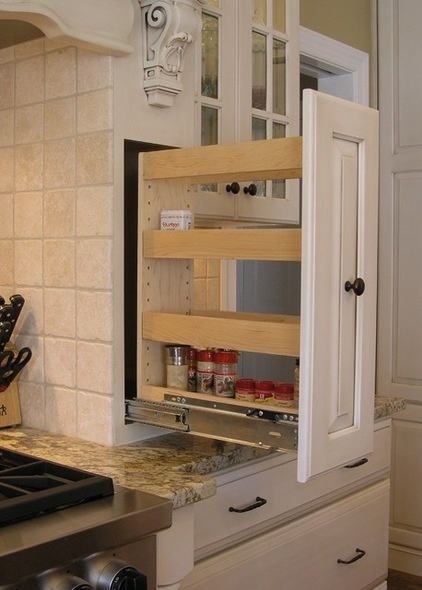
Project: Adding a pullout spice rack.
Why: A pullout spice rack is a narrow shelf that includes a rail system mounted to a cabinet front. Because it’s skinny, usually between 3 and 12 inches wide, the shelving area can often be carved out of space that might otherwise be wasted or inefficiently used. Creating a dedicated location for your spices keeps them handy in a convenient cooking and prep location. Concealing them will also help prevent that annoying sticky residue that ends up on the lids when they’re left exposed.
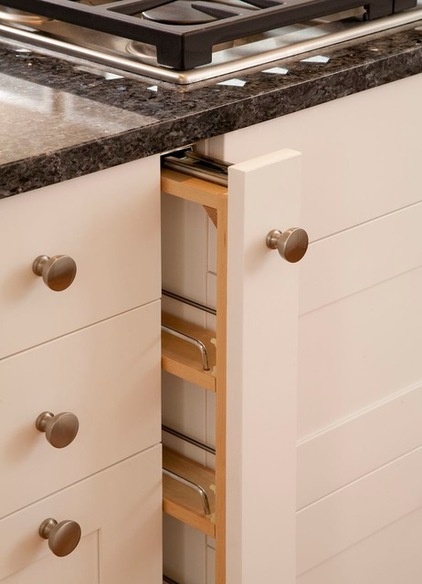
Who to hire: By far the easiest and best way to incorporate pullout spice shelves in your kitchen is to include them in a new cabinetry project. The advantages of this approach are many, but the primary benefit is that it makes the most efficient use of space and you can design your shelves to be located where you want them.
The shelf can be designed to fit in between two new base or upper wall cabinet units, to be integrated in a hood, to flank a cooktop or to fit in what would otherwise be a useless decorative filler panel. In an apples-to-apples comparison between a new and a retrofit pullout cabinet, the new option is less expensive. However, you’ll need to purchase new kitchen cabinets, which as an entire project is much more costly.
Cost if new: Bruce Dexter of Kitchen Fair says you can expect to pay about $65 for a 3-inch-wide filler panel in the base cabinet with a decorative front and roughly $200 for a 12-inch-wide wall unit, inclusive of the casing and front panel. Of course, pricing varies for different cabinet manufacturers, wood species, finishes and hardware. Nonetheless, this is a good cost range to start with.
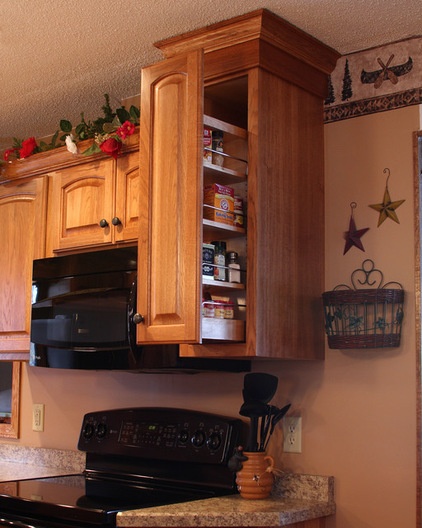
If new kitchen cabinets aren’t in your plans, you can hire a carpenter to modify an existing wall cabinet or filler panel to accommodate a new pullout shelf. Filler panels are leftover spaces usually at the end or sometimes between cabinetry units. It’s not possible to retrofit cabinets to accommodate a sandwiched-type pullout shelf without replacing all the cabinets, so the location possibilities for a retrofit are much more limited.
You may need to add support in the interior of an existing cabinet to accommodate the hardware glides, and the face frame will need to be modified. So, depending on the configuration of your existing cabinet and the width of the new spice shelf, it’s possible you could lose several inches of space. Dura Supreme Cabinetry’s national training manager, Jodi Tramontin, says that with a 9-inch-wide cabinet, you typically lose 3 inches for the face frame, leaving you with a 6-inch opening, which makes installing a spice rack difficult in an narrow opening.
The cabinet front will change from a swinging door to a pull-front, as the new shelf will be anchored to the back of the cabinet facing. Unless your kitchen cabinets have European-style (hidden) hinges or are painted a solid color and you know the paint color number and finish, you’ll need to order a new cabinet face in the same size to eliminate the hinge notches.
This is a major downside, since a lot of folks don’t know the make or style name of their cabinets, or the cabinets are old and discontinued. A very skilled carpenter may be able to fabricate a new cabinet front to closely match the existing cabinets, but it’s very tricky (or impossible) if your cabinets have detailing such as decorative beading or special finish glazes.
Cost if modified: The shelf itself can run $130 to $350 retail. Rev-A-Shelf offers several different sizes and applications in its 432 series and 448 series. You’ll have the labor cost of the contractor or carpenter too. As fees vary greatly in different locations, and site conditions are unique to every project, the labor cost will vary. Contractor Heath Barrett of Ober & Barret Builders says to expect about four to five hours of labor for this type of project. At an average of $50 an hour, that would be about $200 to $250 in labor. So in total, modification of one cabinet could range from $380 to $600.
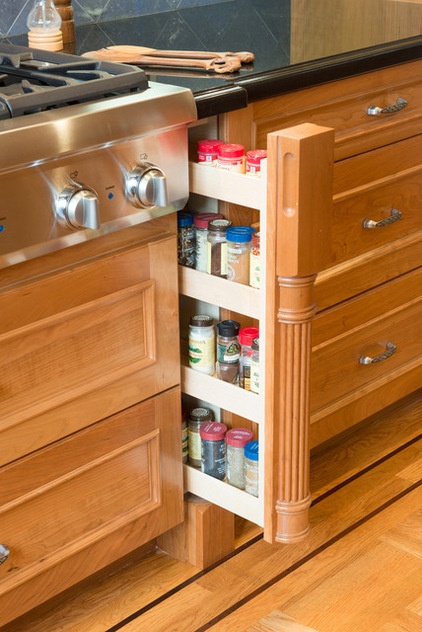
Architectural details: Many homeowners opt to add two 3- or 6-inch pullout spice shelves in the base cabinetry surrounding the cooking area or on opposite sides of a hood. Because of the symmetry and their narrow configuration, they are already columnar in shape. Most cabinet manufacturers offer an array of decorative architectural details for the face, such as with the column shown here, made by Dura Supreme Cabinetry. Other options include turned posts or pilasters, or a filler overlay that matches the rest of the cabinetry. Architectural detailing adds definition and visual interest and often includes a routed-out finger pull so the shelf is easy to pull out and doesn’t require pull hardware.
Tramontin brings up an important point to mull over if you’re considering a pullout shelf in your base cabinet: Many cabinet manufacturers don’t provide a base foot to “lift” the pullout cabinet off the floor, and the bottom of the shelf actually rests on the floor when it’s fully opened. This poses a problem for kitchens with floors that aren’t level floors or areas with a floor mat or rug in front of the cabinet. Dura Supreme designs and manufactures its pullout spice rack to integrate a base foot so the shelf sits several inches above the floor, as shown here.
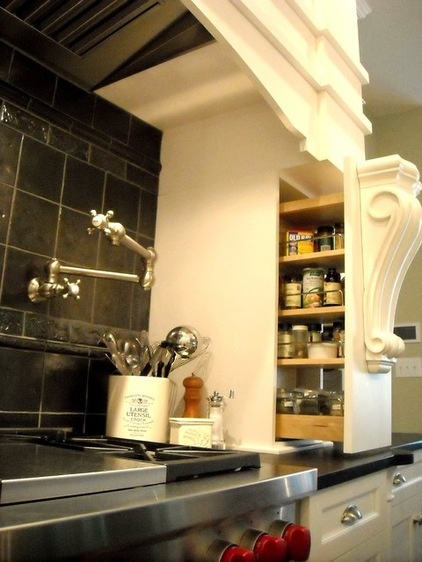
In this kitchen designer Shannon Poe cleverly tucked a pullout spice shelf behind an architectural corbel, which also functions as the shelf’s handle. Poe says one of the goals for this project was to maximize space efficiency, so she added a pair of spice racks integrated into the pillars of the hood design.
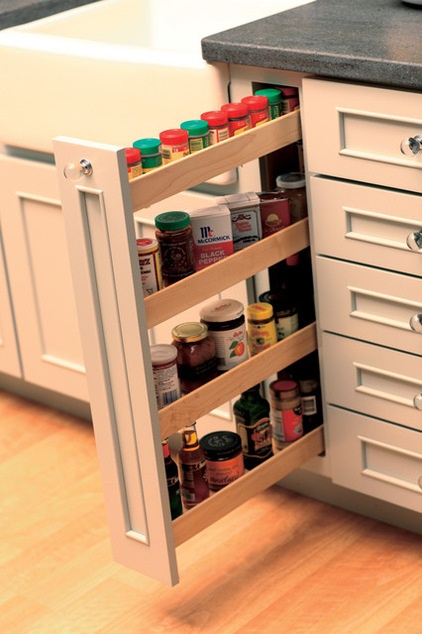
Sizes and expectations: Poe explains, “When I plan for spices in any of my kitchen projects, I always make sure to ask my client what kinds of spices and sizes of jars they use. I want to be sure that they are aware of how their new spice rack will work for them. Not all spice racks can accommodate large jars of minced onion or a tall bottle of oil. It’s important for me to be sure that we have the right size and amount of space for all different varieties.”
Poe says she likes to specify the 6- or 9-inch-wide spice shelves when she can, but she knows from personal experience that even the 3-inch-wide option can handle a good number of spices (she has one in her own kitchen). However, she does tend to discourage clients from using the pullouts in 12-inch-deep wall cabinets, because they don’t hold a lot of spices and the higher shelves are often challenging to reach. Tramontin adds that in a wall cabinet installation, the maximum height of a pullout shelf is typically 30 inches.
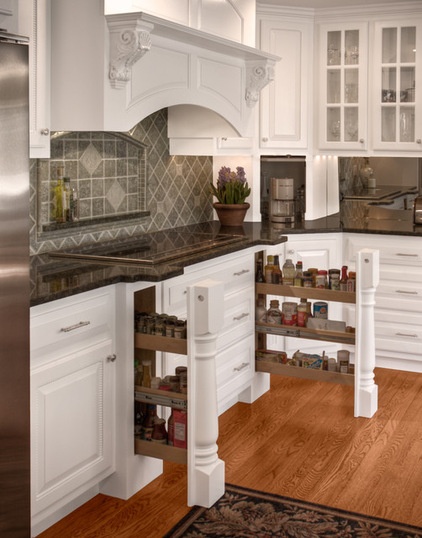
Location: One concern that is brought up repeatedly when pullout racks are located near the cooking area is whether the quality of the spices is diminished because of their proximity to heat and humidity.
Many designers opt to install two pullout shelves in base cabinetry, flanking a cooktop or range but usually not an oven. When the shelf is installed in base cabinetry on opposite sides of a range or cooktop, the heat is concentrated at the countertop level (and upward) and is far enough away from the shelf. However, in a pullout shelf installed next to an oven, the quality and longevity of the spices could be affected.
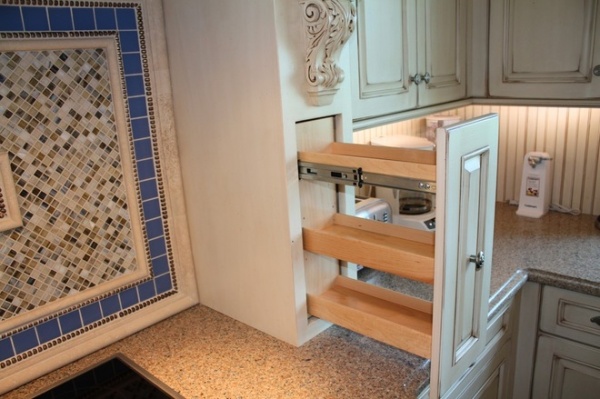
Similarly, a pullout shelf integrated into a pillar flanking a hood would need to be several inches away from the cooking surface, as in this example.
More:
The 15 Most Popular Kitchen Storage Ideas on Houzz
See more Great Home Projects
Related Articles Recommended












